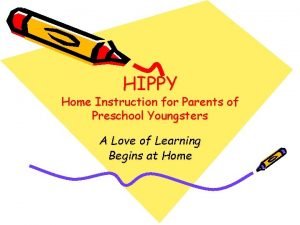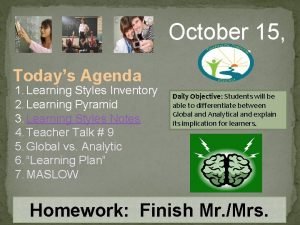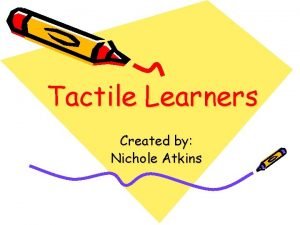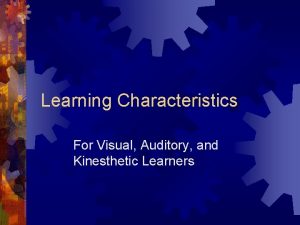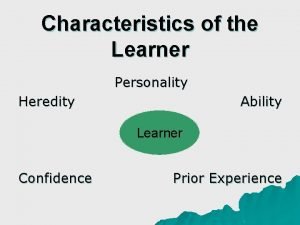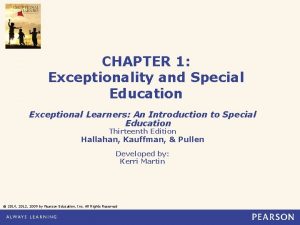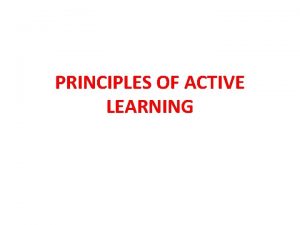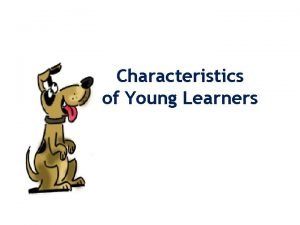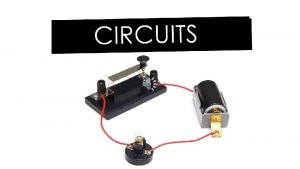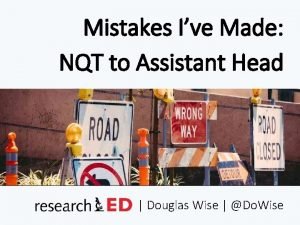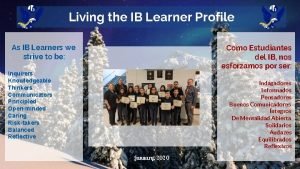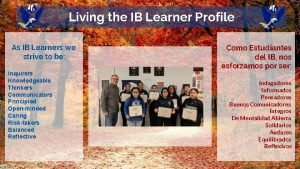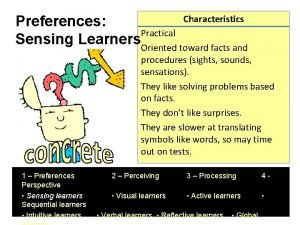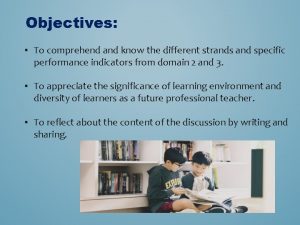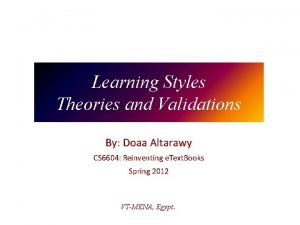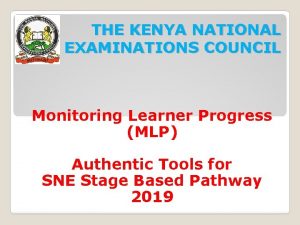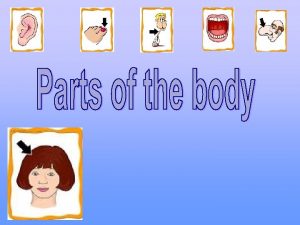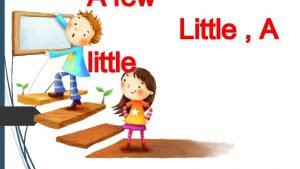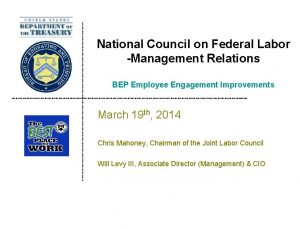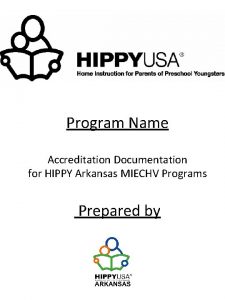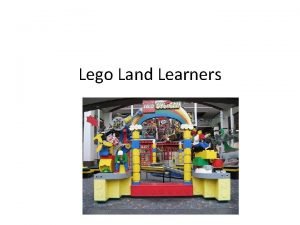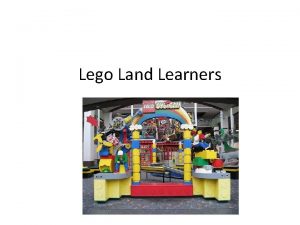HIPPY for Little Learners HIPPY USA Training for



















































- Slides: 51

HIPPY for Little Learners HIPPY USA Training for Coordinators Mary Doyle. HUSA Curriculum Consultant ,

HIPPY For Little Learners WHY? WHAT? HOW? 2

“Just open it and read it. You don’t need a password. ”

“No joystick? No mouse? No keyboard? How do you turn the pages? ”

Inside a Toddler’s Brain

6

IS THERE REALLY A TYPICAL TWO YEAR OLD? ? ? Children need to be surrounded by adults who talk with them, read to them, sing with them, and play with them Every child’s development is unique and complex All children Children develop through the same sequence of steps and milestones, but may not go through at the same time or in the same way The growth and development pattern of children is directly connected to their environment and experiences. 7

Look at all I’m doing! - a toddler’s growth �Absorbing the sounds and meanings of words �Developing motor skills �Laying the foundation for social and emotional competence and happiness.

Wide range of typical behaviors YOUNGER TWOS OLDER TWOS �Require much assistance �Brief attention span �May need multiple sittings to complete an activity �Needs breaks �Express intense emotion but lack understanding or control of emotions �More independent �Enjoys interacting with parent or other adult �Can understand follow two step directions �Need to feel in control �Persistence may be limited

THE AMAZING TODDLER’S BRAIN : Their brains produce more than a million neural connections each second When a connection is made a synapse is formed Young children’s brains Between 24 -36 months children’s brains are 2 ½ times more active than those of adults During these years synapses reach their highest level Then the brain starts to remove synapses that are not used Once a brain forms a synapse it can either be strengthened or weakened That’s why REPETITION is so important 10

REPETITION – TWO YEAR OLDS LIKE: Reading the same book Playing the same games Eating the same foods Using the same cups and utensils Wearing a favorite shirt again and again Sleeping with the same stuffed animal 11


REPETITION – WHY? ? ? Repeating and redoing HIPPY activities adds to the child’s knowledge base Repeating and redoing activities builds confidence Repeating an instruction or direction exposes the child to that vocabulary again 13

REPETITION – WHY? ? ? Repeating strengthens receptive vocabulary Repeating gives the child an opportunity to process and think about the instructions Repetition builds pathways of learning in that little brain 14

REPEAT TO LEARN TO REPEAT 15

Routines �Routines allow children to know what to expect – security �Talk to parents about family routines and making HIPPY a part of their routines �Planning and preparing for an activity enables parent and child to relax and enjoy it �While routines are important, encourage parents to follow their child’s lead

About sharing… �Developmentally appropriate expectations for twos are important �Reduce frustration of parent and child �Help children feel successful �Facilitate learning and growth �Sharing �Emotional regulation �Focus �Memory �Task completion

LEARNING GOALS – Domains and Sub Domains: Language and Literacy Social-Emotional • Attending and Understanding • Communicating and Speaking • Positive Relationships with adults and peers • Emotional Understanding and regulation Cognitive, Discovery, • Explore and Discover • Emergent Mathematics Exploration Physical Approaches to Learning • Gross and Fine Motor • Senses and Self Awareness • Initiative • Curiosity 18

LEARNING GOALS – Bullet Points Drive Parent Information and Activities Outcomes for parents and children Bullet Points Help Coordinators and HV understand the goals Part of WEEKLY TRAINING 19

CURRICULUM: EXPLICITInformation is clear, easy to understand specific SYSTEMATIC – Information is organized, moves from easy to more difficult, is scaffolded, incorporates repetition and review Well developed, effective curriculum 20

HIPPY for Little Learners – Curriculum Components �Parent Information, Education and Support �Spotlight on Development �What Might My Child Do or Say? �What Can I Do To Help My Child Develop?

HIPPY for Little Learners – Curriculum Components �Parent Information, Education and Support �What Your Child Will Learn From These Activities �From These Activities Your Children Will Build These Skills

HIPPY for Little Learners – Domains Every week: �Activities = 5 �Language and Literacy =2 �Think and Explore = 1 -2 �Motor = 1 -2

HIPPY for Little Learners – Domains Language and Literacy �Different but related (and connected) skills �Reading books, talking, singing, laughing, and playing �Exposure to print, writing tools and LOTS of language �Serve and return – multiturn conversations �Rhyme-Rhythm. Repetition

HIPPY for Little Learners – Domains Think and Explore �Investigation and experimentation �Using senses �Asking questions and finding answers �Beginning to connect child’s own experiences to connect to new ideas �Exploring how things work and what they look, feel, smell, taste, sound like

HIPPY for Little Learners – Domains Motor �Using small and large muscles �Movements that improve balance, control, coordination, strength �Skills develop in linear and sequential manner �Exposure and practice

HIPPY for Little Learners Things To Think About and Do �Book recommendations �Extend learning, practice skills and involve family �Three sections each week

CURRICULUM COMPONENTS cont: Family feedback form Your weekly pull page An opportunity for the parent to reflect back on some of the activities along with their child’s performance and report any problems Intended to initiate a brief conversations at the beginning of the visit as both parent and home visitor review the previous week 28

ROLE OF THE COORDINATOR: Who is crucial to the success of HIPPY FOR LITTLE LEARNERS? COORDINATOR The buck stops here! Home Visitors Families HUSA, Supervisors, Agency and/or State Directors 29

COORDINATORS’ RESPONSIBILITIES: Explain the importance of the skills and developmental information Give examples Weekly training sessions must be just that TRAINING SESSIONS Research specific early childhood skills for that week Refer to documents in the guide PREPAR E Refer to weekly guidance documents Research specific early childhood developmental stages for that week 30

KEYS TO STAFF DEVELOPMENT: You are responsible for knowing what is going on in the homes You need to know …. . How are parents and children responding to the activities? Is the child making progress or having difficulties? Does a family need assistance or more information? 31

KEYS TO STAFF DEVELOPMENT: Family Feedback �Family Feedback Form-Before your weekly meeting: �Ask home visitors to flag forms they want to discuss � Add comments, questions, concerns on the back of the page � Parent didn’t fill out the form � Child was disruptive during role play – HELP! � Mom asked for help with transportation � Wants to send older child to preschool – where? �Ask home visitors to highlight positive comments, concerns or questions that some parents had 32

KEYS TO STAFF DEVELOPMENT: Family Feedback �At the beginning of your training session review these comments �You want to know- � Did other parents have these same concerns or questions? � How did the home visitor(s) respond to the family? � What feedback/suggestions do you or other home visitors have? � What information can the home visitor(s) take back to that family? � What information do I, as the coordinator need to research and address at a later time? �It is the home visitors’ responsibility and a valuable opportunity to share information about the successes, strengths, difficulties and limitations of their families. �It is the coordinator’s responsibility to use these forms to make sure families’ needs are being met as well as possible 33

KEYS TO STAFF DEVELOPMENT: Guided Discussion: It is crucial that home visitors be trained and have an opportunity to practice guided discussion Guided discussion in HIPPY FOR LITTLE LEARNERS is used when delivering: 1. Spotlight on Development 2 What Might My Child Do or Say? 3. What Can I Do To Help My Child Develop? 4. What Your Child Will Learn From This Activity 5. Things to Thinks About and Do 34

KEYES TO STAFF DEVELOPMENT: Guided Discussion If you understand the WHAT and the WHY, the HOW makes sense WHAT? ? The interactive process of the home visitor and the parent sharing information and experiences GOALS (11) WHY? ? To gain an understanding of a parent’s knowledge of their child’s development To assist the parent in appreciating their child’s growth and development To stimulate conversation and dialogue To assist the parent in understanding concepts (ideas), educational terms and information 35

KEYS TO STAFF DEVELOPMENT: �Techniques (GPS) for coordinators and home visitors using Guided Discussion: HOW? ? ? Read and become familiar with the material each week – make notes, do additional research if something is unclear Share child development experiences with each other that may be appropriate to share with parents Ask questions of each other to be sure everyone understands the concepts Brainstorm ideas with each other about how to connect with parents of various skill levels Practice engaging parents by asking each other what, when, why and how questions Brainstorm with each other how to connect new information and ideas to existing knowledge about child development 36

KEYS TO STAFF DEVELOPMENT: Spotlight on Development Always page 1 of the packet Trained and delivered using guided discussion Home visitors should have an opportunity to read the entire page before training begins Using guided discussion, the coordinator presents the main topic and any other information that they have researched Encourage home visitors to write a leading question or 2 that will help them begin the discussion with their families on the topic The goal is to educate the home visitor on the developmental topic and to show them how to ask questions and share information that encourages discussion 37

KEYS TO STAFF DEVELOPMENT: What Might My Child Do or Say? What Can I Do To Help My Child Develop? Home visitors take turns reading the bulleted items and sharing examples of questions or situations they will share with parents Involve all home visitors – staff learn best from each other Train home visitors to use effective words such as “why”, “how do you”, “what is the importance of” Discuss benefits of open ended questions: • To assess parents’ knowledge • To determine how (or if) the parent is observing their child • To identify misconceptions that may hinder understanding After training and discussing all of the elements on page 1, choose 2 home visitors to demonstrate, using guided, discussion how the page will be delivered in the home 38

KEYS TO STAFF DEVELOPMENT – DOMAINS: Before starting role play, allow time for staff members to read the following What Your Child Will Learn From These Activities Your Child Will Build These Skills Encourage home visitors to go back after the activity and link the skills so that parents see how they are applied This is another Guided Discussion piece that all home visitors should be prepared to deliver 39

KEYS TO STAFF DEVELOPMENT – DOMAINS: ROLE PLAY Using: KEYS TO ROLE PLAY 40

KEYS TO STAFF DEVELOPMENT: Things To Think About and DO Are home visitors familiar with the Review each bullet recommended point with staff using storybooks? Guided Discussion • Why do you think the This is a way to book was recommended? extend and practice • Encourage home visitor s the activities As the weeks continue some suggestions may be repeated • Why is this good? • How will the home visitor explain this to the parent is the say, “we to get a copy to show the already did this? ” families 41

KEYS TO DELIVERY: EFFECTIVE DELIVERY OF HIPPY FOR LITTLE LEARNERS HINGES ON: 3. Home visitors having an understanding of the 1. Home visitors being skills covered in the comfortable with activities and why they guided discussion are important 2. Home visitors having prepared questions for 4. Home visitors having personal experiences, parents other scenarios, or information from staff development to share 5. Home visitors having all materials to role play and having suggestions for alternative materials if necessary 6. Available tool box of strategies to assist the parent in delivering the lessons based on family feedback 42

KEYS TO DELIVERY: �Model – Spotlight on Development � Joint Attention �Group Role play Week 5 43

KEYS TO DELIVERY – Strategies and Tools: Before any strategies and tools to help families can be developed you must know WHY they are having difficulties. Questions to ask: Is there a parenting issue? Is there an environmental issue? Does the child have any physical limitations? (Hearing, speech, developmental) Is there a problem with the time of day HIPPY is being done? 44

KEYS TO DELIVERY – Scenarios and Tool Box: The following are some common scenarios and suggestions taken from pilot sites’ feedback: 1. My child won’t sit and listen to the entire story 2. My child won’t answer my questions 3. My child won’t follow directions 4. My child gets distracted and sometimes overwhelmed 5. My child wants to do other things with the materials 6. My child doesn’t like to color or doesn’t hold the crayons correctly 7. My child doesn’t like some of the activities 45

KEYS TO DELIVERY - Generic Tools: Model, Model Slow down when asking questions or giving directions JOINT ATTENTION Differentiate or Adapt the activity Repeat the activity and/or questions and directions REPEAT TO LEARN TO REPEAT Limit the number of materials Reread, Reread the storybooks REINFORCE and talk about the skills throughout other experiences 46

REMINDERS – KEYS TO STAFF DEVELOPMENT: Prepare ahead of time Use essential documents in the guide Do research on your own Assess home visitors for understanding Collaborate Ask for help 47

REMINDERS – KEYS TO STAFF DEVELOPMENT: 1. Family Feedback Form Guided Discussion: 2. Spotlight on Devel 0 pment 3. What might my child do or say ? 4. What can I do to help my child develop? 7. ROLE PLAY 8. Things to Think About and Do Domains: 5. What your child will learn from these activities 6. Skills 48

REMINDERS- KEYS TO DELIVERY: Prepare, Prepare Learn from each other and from parents Share appropriate personal experiences Follow guidelines for guided discussion and role play HOME VISITORS Participate in weekly training sessions Ask questions 49

KEEP IN MIND: WE ARE ALL VALUABLE RESOURCES FOR EACH OTHER WHOMEVER DOES THE THINKING, DOES THE LEARNING 3 R’S OF LANGUAGE DEVELOPMENT; RHYME, RHYTHM, REPETITION REPEAT TO LEARN – LEARN TO REPEAT 50

A few administrative notes on using H 4 LL �Assessment and requirement for HUSA reporting �Some child assessments are not developmentally appropriate for children 24 - to 36 -months – Bracken, PPVT, K-SEALS �Use developmentally appropriate assessments like ASQ, ASQ: SE, Brigance, DECA �Just as with Year 1 and Year 2, collect PII for H 4 LL parents �HIPPY USA website is updated for H 4 LL! Do not use materials used in pilot (e. g. , pre/post survey, old weekly guidance). REVISED Weekly Guidance is posted. �Please contact Dr. Jennifer Henk with any questions jhenk@hippyusa. org
 Hippy program florida
Hippy program florida Hippy home instruction for parents of preschool youngsters
Hippy home instruction for parents of preschool youngsters Krooklok meaning
Krooklok meaning Llanolope fly
Llanolope fly 1 little 2 little 3 little indians
1 little 2 little 3 little indians 1 little 2 little 3 little indian
1 little 2 little 3 little indian Kouzon
Kouzon Global vs analytical learners
Global vs analytical learners Grammar examples
Grammar examples Nichole atkins
Nichole atkins Remedial teacher meaning
Remedial teacher meaning Global vs analytical learners
Global vs analytical learners Kinesthetic learners characteristics
Kinesthetic learners characteristics Eager leaner
Eager leaner Facts about tactile learners
Facts about tactile learners When is cognitivism beneficial for learners
When is cognitivism beneficial for learners Visual iconic learners
Visual iconic learners Resolution 435 of the prc
Resolution 435 of the prc Inheritance characteristics
Inheritance characteristics Exceptional learners: an introduction to special education
Exceptional learners: an introduction to special education Assistive technology for english language learners
Assistive technology for english language learners Active learners definition
Active learners definition Involuntary attention definition
Involuntary attention definition Questioning strategies to engage all learners
Questioning strategies to engage all learners Background information for learners
Background information for learners Rigor/relevance framework
Rigor/relevance framework Gifted and talented learners in the philippines
Gifted and talented learners in the philippines Famous people with intrapersonal intelligence
Famous people with intrapersonal intelligence Learners will be able to
Learners will be able to English language learners
English language learners Tkt yl
Tkt yl Teaching young learners english
Teaching young learners english Reading strategies for english language learners
Reading strategies for english language learners Graham nuttall the hidden lives of learners
Graham nuttall the hidden lives of learners Ib learner profile inquirer
Ib learner profile inquirer Ib learners profile
Ib learners profile Equal protection for english language learners
Equal protection for english language learners Global learners characteristics
Global learners characteristics Changing results for young learners
Changing results for young learners Technology for diverse learners
Technology for diverse learners Active and passive learners
Active and passive learners Diversity of learners
Diversity of learners Impulsive learners
Impulsive learners Knec monitoring learners' progress
Knec monitoring learners' progress Fairlie early learners
Fairlie early learners Two little feet
Two little feet What are quantifiers
What are quantifiers Little grains of sand
Little grains of sand A few vai few
A few vai few Little mouse, little mouse where is your house
Little mouse, little mouse where is your house Little a little few a few
Little a little few a few Few, a few, little, a little exercise
Few, a few, little, a little exercise

